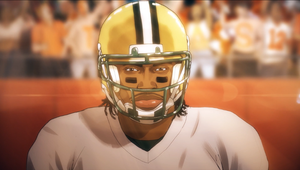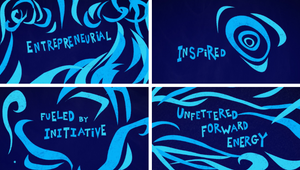Over the course of her 20 year career, Brooklyn-based multidisciplinary artist Chitra Ganesh has built up an eclectic portfolio of work that spans a range of mediums and aesthetics. The native New Yorker has forged an identity as a protean creative by merging themes of iconography and science fiction with preconceived notions of gender and politics. In 2018, Chitra took on a new visual language, as she collaborated with the STUDIO NYC in her first foray into the world of animation.
After a propitious introduction to Chitra’s work in 2014, the STUDIO NYC has worked closely with the artist. As a full service production and animation company, the team has transformed Chitra’s acclaimed drawings and paintings into animated ‘visual poetry’ in the form of ‘The Scorpion Gesture’ and ‘Before The War’.
In this interview, LBB speaks with the artist and the creative team behind the animations - the STUDIO NYC founder and creative director Mary Nittolo, VP and head of production Eric Schutzbank, and lead animator Victor DeRespinis - to find out how these complex works came to life.
LBB > The Scorpion Gesture and Before The War were brought to life through close collaboration between artist and animation/production studio. Could you describe how the process unfolded?
Eric Schutzbank > We started by listening closely to the brief and asking a lot of questions, as we do with all projects.
Mary Nittolo > The creative process of any of our projects begins with research and a kind of educational process for the artists to engage with. We have an extensive art library at the STUDIO, which provides reference materials, and then comes the analysis of the artistic styles. We animate elements that weren’t meant to be animated, which means restoring backgrounds so that figures can move, so the representation of anatomy becomes critical. Then there is the issue of perspective. There is a hierarchy in the source material and a lack of interest in using linear perspective to realistically portray space and depth. Compositing gave us the opportunity to respect the vertical perspective while exploring the illusions of 3d space. Analysing and discussing these issues with the artists involved with the project is done at the beginning of any collaboration.
Eric > Then we needed to translate these physical artworks into digital, animatable assets, with suitable layers. The Rubin Museum was able to provide high resolution scans which involved a lot of careful reproduction work, slicing up pieces of paintings before recreating them, filling in backgrounds or completing figures that felt true to the original work of art, as if they were always there.
Victor DeRespinis > We incorporated the digital scans of Chitra’s art - paintings, drawings, photos, etc. - into layouts as a collage. Then, during post production, we were able to further integrate these works, many of which were never originally intended to be viewed together. This same approach was also applied to the animation process, giving the motion an equally varied feel, further enhancing the mixed media effect.
LBB > What was it like collaborating with Chitra Ganesh? What was your creative process like?
Eric > The Scorpion Gesture was our first collaboration with Chitra and she was fairly new to the animation medium. There was a lot of discussion around the process: how to prep artwork, how to create layouts, how certain effects are achieved, etc. At first this can feel like learning a new language.
When we worked on Before The War, Chitra had a better sense of what she felt worked and didn't work in the medium, as well as how to provide context and information around her artwork and intentions. We found a shorthand, and spent less time trying to unpack the process, and more time expounding upon the possibilities inherent in translating her work from a physical, static space to a digital, motion driven medium.
Chitra > It’s been a process of learning what kinds of images and footage work better and why, and how to break down and prepare the imagery to make the animation process as streamlined as possible. There’s a lot of discussion, exchange and tweaking along the way.
LBB > the STUDIO NYC is passionate about showcasing the work of multidisciplinary artists and forging relationships based on a shared vision. How did you draw upon your skills as a studio for these collaborative projects?
Mary > We needed to use a combination of techniques because the work is complex. Chitra uses figuration and representational images to express abstraction, and a kind of visual poetry ensues in her work that is the result of combining disparate entities. Based on the complexity of the work and her own process, a combination of disciplines seemed appropriate.
Victor > The Scorpion Gesture was a collaboration between Chitra and a team of artists ranging from animators and editors to compositors. With so many moving parts, the use of a multi-media collage-based animation turned out to be a great solution in the end, allowing for a very unique merging of both the historical and contemporary worlds of art. Each piece presented its own challenges. Many of the animated assets were originally created in wildly different styles and mediums, so an overall unification through movement and compositing was key.
Eric > Due to these project’s sizes, scheduling became a challenge, as much of the work was done over the course of many months and often in between other commercial projects.
LBB > The Scorpion Gesture was described by the Times Square Partnership as “a rich and colourful phantasmagoria that explores bodies, space, history, and mythologies”. Can you tell us a little bit about how this project came to life?
Chitra Ganesh > The Scorpion Gesture originated out of a residency I did at the Rubin Museum of Art, where I was invited to create a series of artistic interventions in the Rubin’s collection galleries. I was inspired by artworks relating to Padmasabhava, known to Tibetans as the Second Buddha, and Maitreya, the Future Buddha, whose prophetic arrival is said to usher in a new age at a time when the terrestrial world has lost its way. These various paintings, sculptures and manuscripts became a starting point for what eventually became a series of five animations, each animation responding to the artworks in various ways.
The term ‘Scorpion Gesture’ refers to a mudra (Buddhist hand gesture) that is said to have unlimited power and potential for transformation which has been a long held inspiration for my work.
Victor > The Scorpion Gesture was also our first collaboration together. At the time Chitra was fairly new to the animation process, so I knew it would be both exciting and challenging to interpret her ideas visually while also retaining the integrity of the storytelling. Discussions with Chitra were very freeform, allowing for experimentation and exploration.
LBB > The Scorpion Gesture was featured as a Midnight Moment in Times Square for an entire month in November 2018. What was it like to see it displayed in such an iconic location?
Chitra > It was amazing! What struck me most was how animation can operate at such wildly different scales. From first being displayed on a small scale in darkened rooms, to the massive, differently shaped screens in Times Square, to a five channel life-sized installation in the Kochi Biennial, to a more black box cinema setting at the Mildred Lane Kemper Museum of Art. Of course it was incredibly exciting to see so many people gather in Times Square and experience the work together for an intense three minutes.
Mary > It was pretty awe-inducing in that you sensed the expansiveness and transcendence of the work, and felt the connection with the hundreds of people in Times Square who stopped what they were doing to watch. I was interviewed by the Times Square Partnership with Chitra and Beth Citron, the curator of the exhibition. Knowing this extraordinary project was the result of a collaboration between three women was an amazing feeling.
Victor > Being able to see work you’ve spent so much time on shared in different settings and on such a large scale was very gratifying. It was humbling to see so many people engaging with and captivated by the work.
Eric > Absolutely! It was a blast to go with the team and see the reactions of people on the street. New Yorkers usually aren’t fazed by much, but people were stopping to take a look.
LBB > Before The War explores an open ended narrative of memory, love and loss, animated by the social and political shifts catalysed by the 2020 pandemic. What was your initial concept for this project and where did you find inspiration?
Chitra > Before The War began with an invitation from artist Saul Williams to use his song as a springboard for a short animation back in 2019. I’d long been a fan of his; he is a true polymath. He was very open about me making my own interpretation of the song, and it was important for me that he appear as a character in the animation. As we all emerged from the 2020 lockdowns, he was out of the country working on his directorial debut, but has been incredibly supportive and encouraging throughout the process, and I hope we can integrate the animation into one of his live performances one day.
LBB > How and what changes in the political landscape influenced Before The War?
Chitra > The way the pandemic highlighted deeply entrenched inequalities and racial injustice was certainly an influence, as was the climate crisis, the connection between misinformation, vaccine denial, and authoritarian governance models. For me, it's not just a matter of revisiting the past, but reorienting ourselves to it, reflecting on the past in a way that upends ideas of teleology and progress. I feel the future and the past are not consecutive points on a straight line, they are much more dynamically and dialectically involved.
LBB > There is a common theme of the divine feminine throughout your work, how did this theme manifest in both works? Chitra > The move to represent multiple iterations of the body and femininity has always been important to my work. In the mythic narratives that inform some of my figurations, there's almost always a portion of the story that loops around how the body came to be what it is, and the inextricable relation between creation and destruction. I am interested in how certain stories have implications for the cerebral, shifting gender, and expanding what we have come to know as the normative body. This isn't about the body being a site of harm or liability; rather, such narratives offer different propositions for bodily configurations and how bodies can exist, often paradoxically embedded in misogynist stories.
LBB > What’s next for you? Chitra > I’ve currently got works on exhibition at the Hawaii Triennial and the Seattle Asian Art Museum, as well as a solo show at the Mildred Lane Kemper Museum of Art in St Louis. I’m now working on a commission for an exhibition in Munich called ‘To Be Seen: Queer Lives 1900-1950’ and also gearing up for a solo show at Calgary Contemporary in October. Mary > We are working on a number of fascinating projects at the moment: branding for a brewery opening in Hudson, NY; an animation about the toxicity of certain social media content on young girls; a beautiful abstract animation for a financial services company set to a wonderful jazz score; a pilot with Chef Grace Ramirez for a food network; and a pre-school show based on our own IP.















